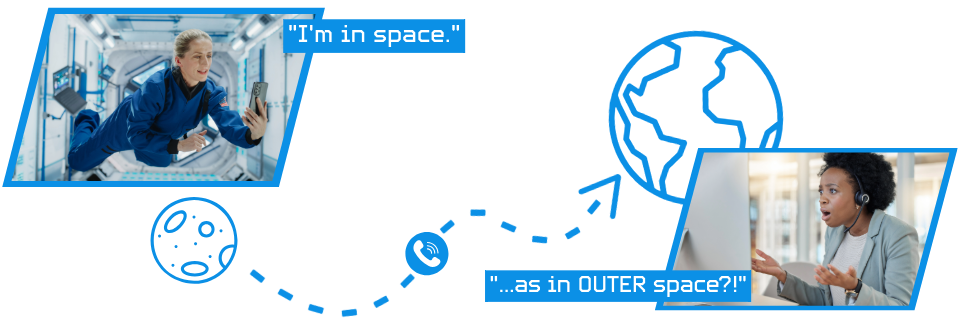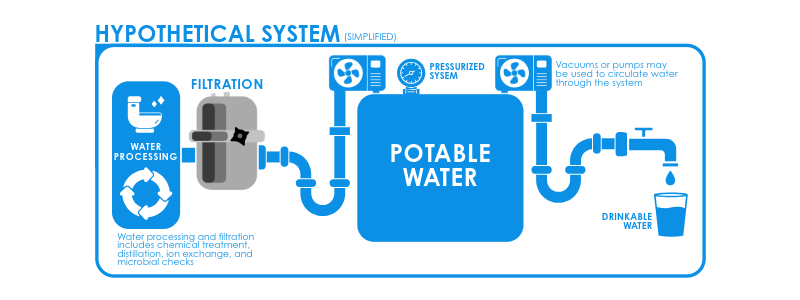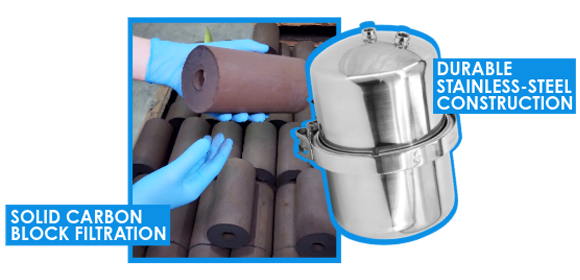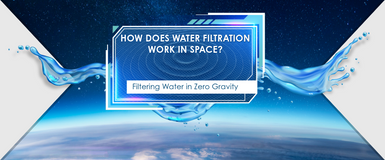Posted by Travis Richards on Apr 8th 2025
How Does Water Filtration Work in Space?
The Science Behind Filtering Water Without Gravity.
It all started as a joke. One astronaut playfully flicked a droplet of water toward another during their downtime aboard their spaceraft. The droplet floated forward as a perfect shimmering sphere drifting slowly through the cabin. The other astronaut laughed and tried to swat it away with their hands, but it split into a dozen smaller beads of water that scattered away. Some droplets clung to the walls, others hovered mid-air, and a few started making their way toward the ventilation system intake. Suddenly, it wasn’t so funny.

In space, water doesn’t behave the way we’re used to. Because of surface tension and adhesion, it sticks to everything from equipment to wires, and even astronauts. If it gets into the wrong place, it can be dangerous. A single rogue droplet could short out electronics or block airflow. That’s why managing water in zero gravity isn’t just an interesting topic... it’s essential.
While this story is a bit dramatized, one stray droplet won’t immediately threaten safety due to proper training and genius engineering. But for astronauts, dealing with water can be a real challenge—especially when it comes to drinking water in space. Here on Earth, in unpressurized systems, gravity does most of the work, pulling water through filters with ease. But in space, there is no gravity to guide the flow, which means the entire water filtration process has to be reimagined. Figuring out how to filter water in a weightless environment pushes the boundaries of science and engineering. And the solutions we discover up there just might help us improve the way we get clean water down here on the ground.
|
FOLLOW US FOR A FRESH TAKE ON WATER |
|---|
Why Water Filtration in Space Is a Whole New Challenge
On Earth, filtering water is pretty straightforward. It flows through one end of a filter and out comes the clean water on the other end. Whether it’s a gravity-fed filter or one hooked up to your faucet using water pressure, gravity is still doing a lot of the heavy lifting. It’s what helps push water through the filter medium and keeps everything flowing where it’s supposed to go. You can’t just let water drip through a filter when there’s nothing pulling it. That creates a problem for drinking water in space.
And when we think about space, we’re not just talking about a quick trip to the International Space Station. Space is big... UNFATHOMLY big. As future missions venture farther from Earth, maybe to Mars or beyond, the systems that support life must work flawlessly and without interruption... That includes water filtration.
There’s no room for error, and no quick fix if something goes wrong. If something breaks down, the astronauts can’t just call up tech support and request a replacement. That would take months, if not years, to get them their replacement parts, and if one of these vital systems such as water filtration goes down, they may not have that long to wait before their circumstances become dire. In deep space, reliability isn’t a convenience... it’s a matter of survival.

Clean and safe water is crucial for astronauts, but without gravity to move it, even the simple process of moving it from one place to another becomes a high-tech challenge. It’s not just about the water filter itself, but it’s about finding a safe, reliable, and energy-efficient way to actually move water through the entire water treatment system in a zero-gravity environment.
Making Clean Water Happen in Microgravity
So, how do astronauts actually filter water in space if they don't have gravity to help them out? The answer isn't as easy as you'd think. It's all about rethinking the rules and the outcomes, since it is likely that any action you take in zero gravity will have a different outcome than if you took that action on Earth. Water won't flow on it's own if there's no gravity. That’s where pumps or suction systems come in. They create the pressure that is needed to push or pull water through the filter.

Containment also becomes a very important issue. In zero gravity, everything loves to drift and eventually cling to surfaces. Astronauts shouldn't have to worry about turning on a water faucet to get a drink and have water squirt across the cabin where there’s a risk of it getting into vital systems. Especially when replacement components are months away, if they are even repairable at all. A sealed, closed-loop water filter system keeps everything where it needs to be, and prevents rogue water droplets from disrupting the astronauts' pleasant ride through the cosmos.
When it comes to the filter, it has to be specially designed. Traditional, gravity-fed filter media won’t cut it. In space, filters need to work without relying on gravity, using fine-tuned materials that trap and adsorb contaminants while still allowing clean water to pass through under pressure, something like a solid block of activated carbon or a membrane.
Designing a Water Filter System for Life in Space
When it comes to zero gravity water filtration, what does this system actually look like? In the end, you get an easily controlled, energy-efficient, closed-loop system that doesn’t wait for water to flow, but instead it actively moves it through the filtration system. Water pumps or suction force the water though a specialized filter that adsorbs contaminants as it passes through, leaving the astronauts with clean and safe water.
To make that happen, the water filtration system must be more than just effective—it has to be smart about how it uses resources. Just like with everything on a spacecraft, power is limited, so the water filtration process needs to be energy-efficient, and it must run smoothly without draining any of that precious power. And as a mission-critical system, it needs to work with as little risk as possible. So, the water filtration system must operate with minimal dependence on complex computer controls. It must be low-maintenance, reducing the risk of something going wrong when the astronauts are millions of miles away... or maybe even lightyears away.

Not only does it have to be functional, but it also has to be small enough to fit into tight quarters, clean enough to meet strict health standards, and reliable enough to work without constant maintenance. When you’re drifting through space, every drop of clean water counts, and the system needs to function flawlessly every time you need it.
Earth-Benefiting Innovations in Water Filter Technology
 Now it’s time for the cool part (as if the rest of this wasn’t already cool). Designing water filters for space doesn’t just help astronauts, but the technological advancements also benefit us here on Earth. When these systems are designed, engineers strip everything down to the essentials which means compact size, lower power use, and maximum reliability. In normal household usage, it’s easy to just shove a system under a countertop or stow it in the fridge and forget about how much space it’s actually taking.
Now it’s time for the cool part (as if the rest of this wasn’t already cool). Designing water filters for space doesn’t just help astronauts, but the technological advancements also benefit us here on Earth. When these systems are designed, engineers strip everything down to the essentials which means compact size, lower power use, and maximum reliability. In normal household usage, it’s easy to just shove a system under a countertop or stow it in the fridge and forget about how much space it’s actually taking.
To meet the demands of both space and Earth-based challenges, researchers and companies have had to rethink what a water filter can do. That means developing reliable and efficient filtration media. One example is carbon block filtration. This method packs activated carbon into a dense, solid block. This design increases surface area, which also increases the contact time for the water flowing through it, making it incredibly effective at removing a wide range of contaminants. Multipure has been at the forefront of refining this technology for over 50 years, creating activated carbon block filters that are not only powerful, but also compact and dependable... qualities that make them just as valuable on Earth as they would be in space.
Though, this kind of space-age thinking is exactly what we need for things like emergency response kits, helping those who are recovering from natural disaster, or supplying a clean water solution to remote villages with minimal or no water infrastructure. By solving the problem of drinking water in space, we also build smarter, more efficient water filtration systems for some of the toughest conditions on Earth. Just because space tech is futuristic, it doesn’t mean it can't be practical.
Water Filtration Systems That Are Ready for Anything On Earth... And Beyond
Filtering water in zero gravity isn’t easy, but the challenge has pushed scientists and engineers to think in entirely new ways. Their innovative ideas help build us better, smarter water filter systems for Earth. So, whether you live in a city apartment, or a remote cabin, the need for clean water is universal.
You don’t need to be traveling to Alpha Centauri, or even just orbiting Earth to understand the need for clean, healthy water and a reliable water filtration system. For example, Multipure's carbon block filters aren’t just built to handle tough contaminants, but they’re engineered for performance and backed by science. These filters are specially designed to reduce a broad range of contaminants, including chlorine, lead, VOCs, and even microscopic particles as small as one half of a micron.
Multipure’s dedication to clean water includes over 50 years of innovation and is backed by NSF Certifications, a third-party seal of approval that proves they regularly meet strict standards. That means every drop of water isn’t just cleaner, but it’s also safer and better tasting. Whether you’re using it in your kitchen, or attaching it to your spacecraft, this kind of reliable filtration is exactly what modern water systems demand.
Attention NASA team, if you're reading this, let's put Multipure to the test! Our filters are ready for any cosmic challenge, because here on Earth, making clean water should be simple... not rocket science. Even astronauts desrve the best water they can get.

